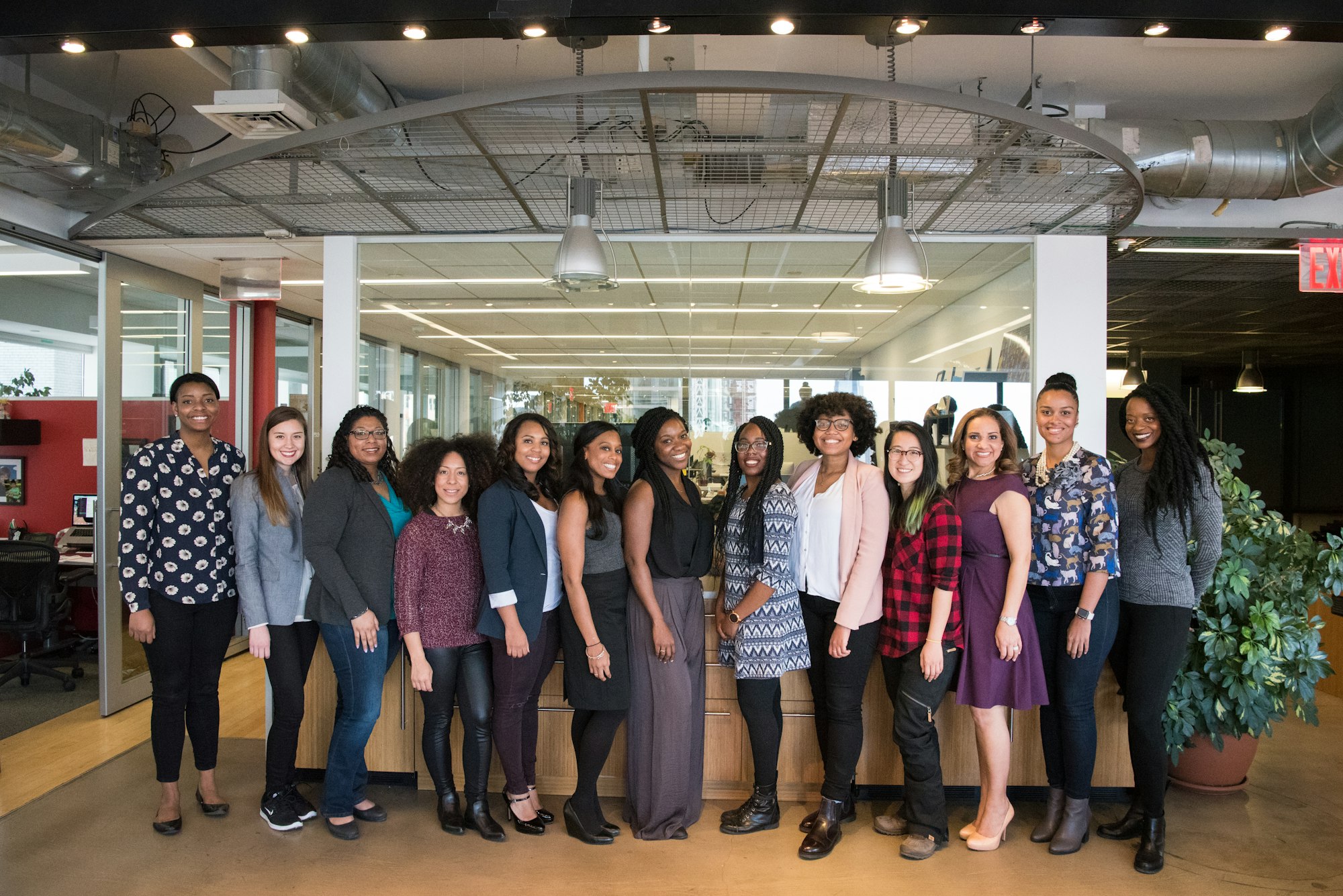Diversity and Inclusion in the Workplace: A Complete Guide
Diversity and inclusion, popularly known as D&I, is gaining momentum in the corporate world. More and more companies are focusing on being diverse by incorporating D&I policies at all workforce levels.
“Companies that embrace diversity and inclusion in all aspects of their business statistically outperform their peers.” – Josh Bersin.
However, making your company diverse and inclusive is much more than a matter of ethics. It is also a driving force of growth, revenue, and profit.
This guide on Diversity and Inclusion will tell you everything you need to know about this crucial topic.
- What is Diversity and Inclusion?
- What is Diversity?
- The Different Diversity Types in the Workplace
- What is Inclusion?
- Difference Between Diversity and Inclusion
- The Risks of Confusing Diversity with Inclusion
- Ways to Improve Diversity and Inclusion in the Workplace
- The Many Benefits of Fostering Diversity and Inclusion in the Workplace
- Diversity, Equity, and Inclusion: DEI in the Workplace
- Figures and Trivia
- Wrapping Up
What is Diversity and Inclusion?
Diversity and Inclusion refer to the set of strategies, policies, and missions adopted by a company to create and encourage an inclusive workplace that attracts a diverse pool of talent from various cultural backgrounds.
Apart from being a business advantage, companies with D&I policies and practices are more creative and supportive of different voices, thus attracting the top talent in any industry.
Although clubbed together, diversity and inclusion are two different terms. Let's understand separately.
What is Diversity?
The 2018 Gallup Report defines ‘Diversity’ as the “full spectrum of human differences.” It refers to unique characteristics in people along the lines of gender, sexual orientations, religious beliefs, age, ethnicities, races, geographical locations, cultures, class, physical abilities, etc.
Diversity in the workplace refers to an organization’s workforce comprising people from different genders, sexual orientations, religions, races, ethnicities, ages, etc.
Diversity can be of many types. Let us have a look at what these are.
The Different Diversity Types in the Workplace
There are different types of diversity in the workplace. While some are visible to the world, others are much more internal. Some can be controlled and changed, and still, others remain the same.
Here are the different types of diversity dimensions that you will find in any workplace:
1. Internal
2. External
3. Organizational
4. World View
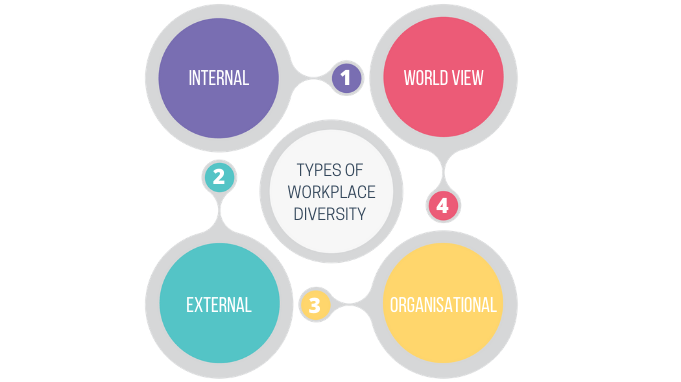
1. Internal Diversity Types:
Internal Diversities are the various diverse factors that a person is born into or belongs to. In most cases, a person has no control over changing these diversities. These include factors like:
- Race
- Age
- Ethnicity
- National Origin
- Cultural Diversity
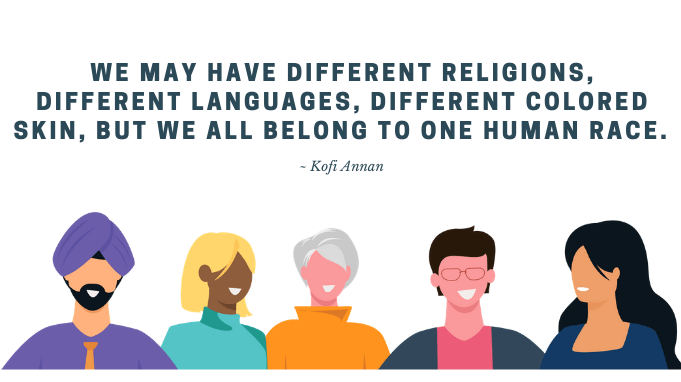
2. External Diversity Types:
External Diversity is those diversities or characteristics related to a person; however, they are not born into it. In other words, these characteristics can be changed or modified by a person. External diversities include:
- Education
- Skills and Interests
- Religion
- Geographical location
- Relationship Status
- Socioeconomic Status
- Experiences
- Citizenship

3. Organizational Diversity Types
Organizational diversities are the different diversity factors that pop up in any organization or workplace. The different types of Organizational Workplace Diversity are:
- Work location
- Job function
- Department
- Management Status
- Level of Seniority

4. World Views
World View Diversity is precisely what the term suggests: the difference and diversity in people’s world views. Our unique experiences, knowledge of history, beliefs, political philosophies we subscribe to, etc. can shape our world views.
World view diversity might include the following:
- Political Beliefs
- Knowledge of History
- Cultural Events
Related Article: 7 Types of Diversity Modern Workplaces Must Focus On
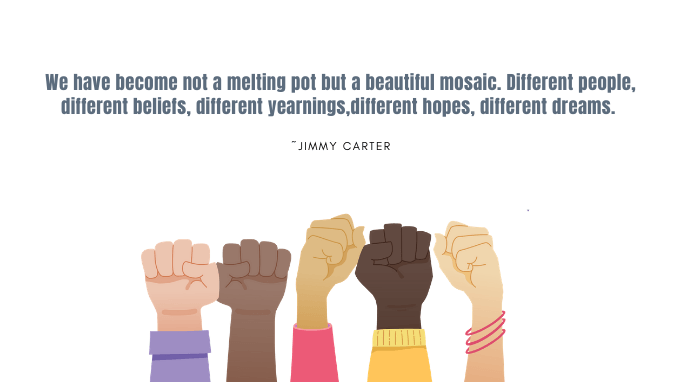
What is Inclusion?
“Inclusion is not a matter of political correctness. It is the key to growth.” — Jesse Jackson, Politician and Civil Rights Activist.

SHRM defines ‘Inclusion’ as “the achievement of a work environment in which all individuals are treated fairly and respectfully, have equal access to opportunities and resources, and can contribute fully to the organization’s success.”
Inclusion in the workplace means ensuring that every employee feels included and a part of the team. An inclusive workforce will feel valued, seen, heard, and respected. Consequently, you will notice a boom in innovation, higher cooperation, and increased employee engagement.
Johnny C. Taylor, Jr., the CEO of the Society of Human Resource Management, mentions that many companies are now swapping the D&I label for I & D so that the primary focus is on implementing inclusion policies at all levels.
Related Article: 11 Powerful Ways to Nurture Inclusion at the Workplace
Difference Between Diversity and Inclusion
The 2018 Gallup Report said that the first step in creating a diverse and inclusive culture is acknowledging the fact that diversity and inclusion are two different concepts.
Companies must not confuse diversity with inclusion. Although clubbed, and talked about together, both the terms are not synonymous, and one does not automatically imply the other.
Let us understand the differences between the two.

Diversity without inclusion will not amount to any significant change in the company culture and employee experience. For instance, you might hire african americans, or women of color to create ethnically diverse teams. But unless and until you take into account their opinions, perspectives, and experiences while making decisions and policies, you are not walking the talk on inclusion.
According to a Harvard Business Review article, “In the context of the workplace, diversity equals representation. Without inclusion, however, the crucial connections that attract diverse talent, encourage their participation, foster innovation, and lead to business growth won’t happen.”
The Risks of Confusing Diversity with Inclusion

If your company confuses diversity for inclusion, it attracts a myriad of risks and ill-consequences. Here is a brief discussion of a few of them:
-
Without an inclusive approach in place, your company will risk the psychological safety of your valuable employees. In the absence of psychological safety, employee engagement will be a bare minimum, and they will hardly succeed professionally.
-
It is now a fact that companies integrate D&I policies into their work culture not only for ethical reasons but for profitable business outcomes as well. Compromising on inclusion will mean that employees will not feel free to participate in the decision-making process actively, and hence, business performance will suffer.
-
Suppose you hire a diverse workforce but fail to make them feel included in the team. The sense of alienation and negative feelings towards the company will take hold. Thus, your diversity policies might backfire on you if they are not balanced well with inclusion policies.
Ways to Improve Diversity and Inclusion in the Workplace
Photo by Christina @ wocintechchat.com / Unsplash
Building a diverse and inclusive workplace has become a crucial part of a company's overall growth and development.
So, the HR and office administration of your company must take tangible steps to create a workplace that is committed to diversity and inclusion.
Here are a few diversity and inclusion best practices for 2021:
1. Educate People In Leadership Positions
As an HR practitioner, you must introduce and lay down strategies for your company’s D&I policies. However, it’s always questionable whether company leaders consider these diversity and inclusion efforts to be essential to the company.
Thus it is crucial to hold educational sessions and meetings in the workplace, where these concepts are explained and discussed in detail. You can also recognize special events like Juneteenth and Pride Month by holding educational sessions.
Help your leaders understand the significance and history of these events so they can internalize an inclusive attitude to deal with a diverse workforce. They need to be held accountable for their words, decisions, and behaviors so that they can lead by example.
Moreover, leaders should also be made aware about how different leadership styles contribute to inclusion in the workplace. For instance, with transformational leadership, leaders can inspire and support employees to re-evaluate their judgments and prejudices towards coworkers. Similarly, a transactional leadership style can create an unbiased workplace. This leadership style focuses on fixed operating ways and outcomes. As long as employees produce results, they are rewarded, regardless of their diversities.
Training your managers and leaders in inclusive policies will thus ensure that the lower-level staff in your workplace feel included when interacting with each other and their seniors.
2. Set Up A Council
Setting up a council of dedicated members who are committed to inclusivity in the company can be a good step in the process.
The council itself should be as diverse as possible. Ideally, it should consist of members of the company who belong to different genders, age groups, ethnicities, races, sexual orientations, religions, and even geographical locations. Only then will there be voices, perspectives, and opinions from all walks of life.
3. Focus on Hiring Diversely
Diversity starts with the hiring and recruiting process.
It is essential to consciously reach out to underrepresented groups while you are recruiting for your company. Diversity and inclusion is a conscious decision, and not something that happens by chance.
When you hire more women, people of color, differently-abled people, etc., you are welcoming a pool of untapped talent and perspective into your company culture.
For instance, according to McKinsey, the most gender-diverse companies are 21% more likely to achieve above-average profitability.
Implementing diversity hiring in your organization can result in a bigger and better talent pool, encourage different perspectives, and enhance collaboration.
Related Article: 7 Benefits of Promoting Gender Diversity in the Workplace
4. Replace Culture Fit with Culture Add
A Culture Fit approach focuses on familiarity. It encourages more of what is already working. On the other hand, a Culture Add approach focuses on welcoming new voices and talents that will positively impact the company culture.
The Culture Fit approach limits or somewhat lacks diversity. It prohibits a company from welcoming new talent.
With the Culture Add mindset, both employers and employees can address their own unintended and unconscious biases that come into play while making decisions.
5. Connect and Communicate
Like we already mentioned, diversity does not guarantee inclusion.
Even if you have an extensively diverse team at your disposal, you might fail to achieve inclusivity. One of the best ways to have an inclusive company culture is through constant communication and connection.
Every employee at every level should feel included in the process. Reach out to them, hear what they have to say, empathize, and learn where their ideas are coming from.
In today’s digital working spaces, constant communication has taken prime importance. Make sure you are accessible to your employees, especially the ones working remotely. Practicing and incorporating diversity and inclusion values through constant communication is central to the remote working culture's smooth functioning.
Listen to this podcast: Diversity and Inclusion in the Remote Workplace
6. Diversity and Inclusion Training
Employees from all levels must undergo diversity and inclusion training at their workplace.
Such activity will educate both employers and employees on how they can best work with people from different religious, geographical, racial, and socioeconomic backgrounds.
Diversity and Inclusion Training will make your employees more aware. They learn specific skills that help them to communicate and collaborate better.
Related Article: 7 Steps To Create A Diversity Training Program
7. Encourage and Enable Creativity and Innovation
One of the most significant advantages of a diverse workforce is the increased creativity and innovation in the workplace.
Employers should do their best to encourage employees to bring out their best creative and innovative ideas to the table. This will make employees feel seen and appreciated and usher in new avenues of business growth and success.
8. Keep a Check on Diversity and Inclusion Initiatives
To have effective D&I Initiatives in place, leaders need to check on these initiatives from time to time.
The best way to measure if a company’s D&I strategies are effective is by measuring metrics like employee productivity, employee morale, and employee engagement. These metrics should give a clear picture of how accepted, appreciated, and welcome employees feel in their organizations.
Making employees feel included is a dynamic process. And this process also includes accepting and celebrating employees' religious beliefs. For instance, during Ramadan, supporting and empathizing with employees observing fast and other rituals is a great way of expressing thoughtfulness.
Creating a prayer space at the office, holding Iftar dinner parties, and distributing gifts during Ramadan are wonderful ways to make employees feel included.
Related Article:15 Activities of Diversity and Inclusion in the Workplace
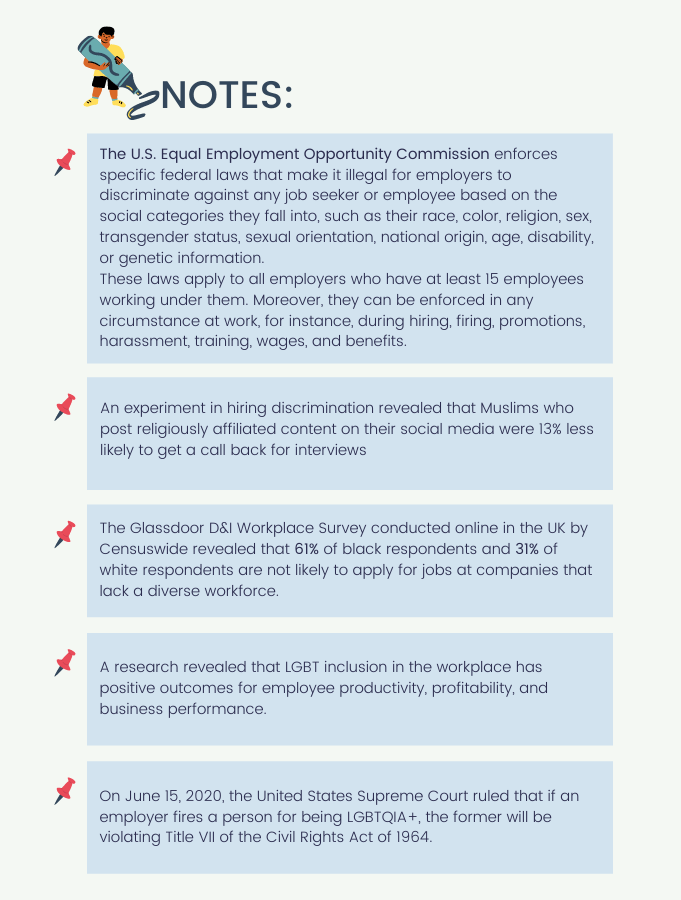
The Many Benefits of Fostering Diversity and Inclusion in the Workplace

Introducing policies for and embracing Diversity and Inclusion in the workplace is much more than a progressive trend.
Companies and organizations have witnessed positive employee engagement, employee retention, innovation, and revenue, after incorporating D&I in their approach.
Here are the many benefits of fostering diversity and inclusion in the workplace:
1. Higher Employee Engagement
This benefit is absolutely a no-brainer. The more included and valued the employees feel, the higher will be their engagement in a company.
Employees participate and are interested in the company culture and activities when they know that their voices matter.
2. Higher Innovation
Diverse people have come from varied backgrounds and life experiences. It enables them to present fresh ideas and creative solutions for any company’s problem.
John Bersin's research shows that, inclusive companies are 1.7 times more likely to lead in innovation in their respective markets. New ideas lead to innovative solutions to address issues at hand.
3. Increased Revenue and Profits
Being a diverse and inclusive company will bring you tangible profits in the form of revenue as well.
Increased employee engagement, employee retention, and higher innovation contribute to higher revenue and profits. According to McKinsey and Co.'s research, companies that push the values of diversity and inclusion in the workplace were at the top of finances and profits.
4. Better Decision Making
Having a diverse range of voices in your team and making them feel valued and heard will allow you the privilege of having a blend of perspectives in every decision-making process.
Including a range of insights from everybody will automatically guide you to make better decisions for the company.
5. Higher Employee Retention
Companies with a diverse and inclusive outlook have a reduced employee turnover rate and a relatively higher employee retention rate.
Naturally, job seekers and employees are more likely to stay in an organization with a history of practicing diversity and inclusion at all levels. When your employees feel included, they tend to last longer and give their best as well.
6. Boost to Company Reputation
Encouraging diversity and inclusion in the workplace will boost the company’s brand identity as well.
In light of the current global political scenario, where representation is at the core of most discourses and narratives, it is imperative to be inclusive. Being politically aware and empathetic can do a lot to boost your company’s reputation.
Related Article: 7 Key Advantages of Diversity in the Workplace and Why It Matters
Diversity, Equity, and Inclusion: DEI in the Workplace
Many workplaces today focus on DEI instead of D&I. DEI stands for Diversity, Equity, and Inclusion.
Equity has become just as crucial as D&I in several global companies.
Equity in the workplace refers to fair and impartial processes and outcomes for each individual in the company.
To ensure fair and impartial processes and outcomes, leaders and employers need to be mindful of the challenges, barriers, and advantages at play for everyone at any given point in time.
Equity is the reminder that not everyone starts at the same level playing field, and so swift action is paramount to building a fair workplace.
Related Article: How to Promote Workplace Equity? Here are 7 Effective Ways!
Figures and Trivia
Here are some interesting and concerning statistics and trivia about diversity and inclusion trends in the workplace.
-
The Glassdoor D&I Workplace Survey conducted online in the UK by Censuswide revealed that 61% of black respondents and 31% of white respondents are not likely to apply for jobs at companies that lack a diverse workforce.
-
A research by Deloitte reveals that a diverse workforce is 30% more likely to spot and recognize mistakes.
-
The U.S. Equal Employment Opportunity Commission enforces specific federal laws that make it illegal for employers to discriminate against any job seeker or employee based on the social categories they fall into, such as their race, color, religion, sex, transgender status, sexual orientation, national origin, age, disability, or genetic information.
These laws apply to all employers who have at least 15 employees working under them. Moreover, they can be enforced in any circumstance at work, for instance, during hiring, firing, promotions, harassment, training, wages, and benefits. -
The U.S. Equal Employment Opportunity Commission (EEOC) has issued four documents related to protecting employees against disability discrimination as a part of anti-discriminatory laws.
-
The US Department of Labor’s Office of Disability Employment Policy (ODEP) aims to increase the employment opportunities for disabled people by giving them access to “training, education, employment supports, assistive technology, integrated employment, entrepreneurial development, and small-business opportunities.”
-
Statistics reveal that racially diverse teams perform better than non-diverse teams by 35%.
-
An experiment in hiring discrimination revealed that Muslims who post religiously affiliated content on their social media were 13% less likely to get a call back for interviews.
-
Research says that LGBT inclusion in the workplace has positive outcomes for employee productivity, profitability, and business performance.
-
On June 15, 2020, the United States Supreme Court ruled that if an employer fires a worker for being gay or transgender, the former will be violating Title VII of the Civil Rights Act of 1964.
-
A report by SHRM reveals that 41% of managers avoid hiring diversely because they are ‘too busy’ to implement diversity initiatives.
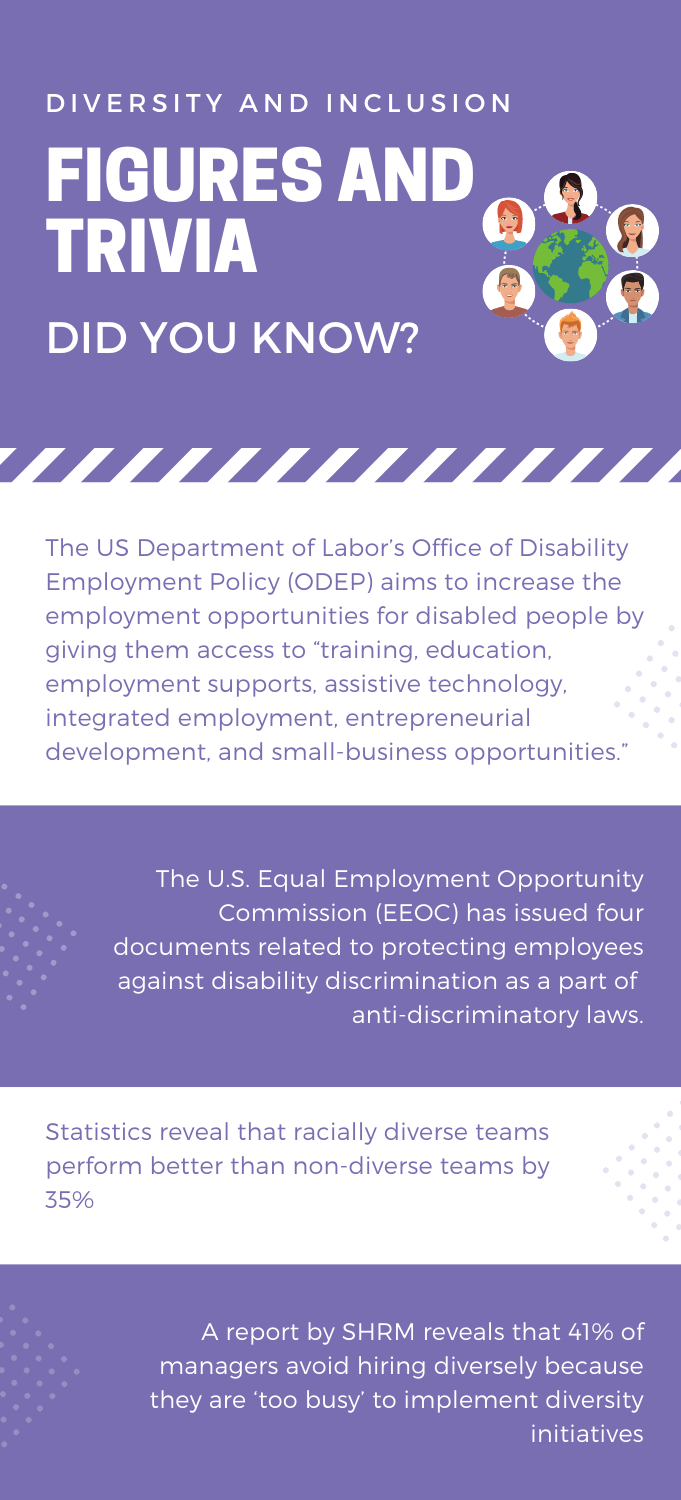
Wrapping Up
Employees are the fuel and driving force of any organization. They have the right and tremendous power to hold their employers accountable and ask them about the latter’s steps to make a diverse workplace an inclusive one.
According to Michael Bach, they can ask them about factors like employee resource groups, diversity councils, the policies and procedures in place, etc.
It is worth mentioning here that On 30th September 2020, Glassdoor launched company diversity and inclusion ratings on a 5-point scale, so that job-seekers have information about companies that are committed to creating a diverse and inclusive workforce.
Here are the ratings for the first 12 companies as rated by the employees based on their experience and satisfaction levels with the D&I policies in place: Salesforce tops the list with a rating of 4.6.

In a world fighting for and standing up for representation, upholding diversity, and inclusion at all walks of life should be an obvious moral and ethical choice.
Moreover, companies and organizations need to realize that their D&I policies can lead them to growth and success, and more massive business impact.











